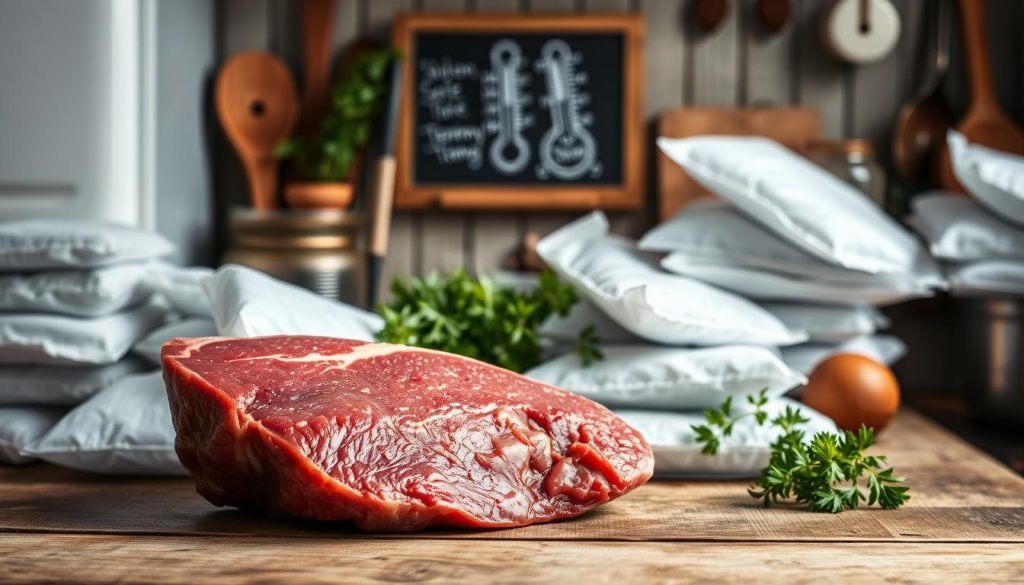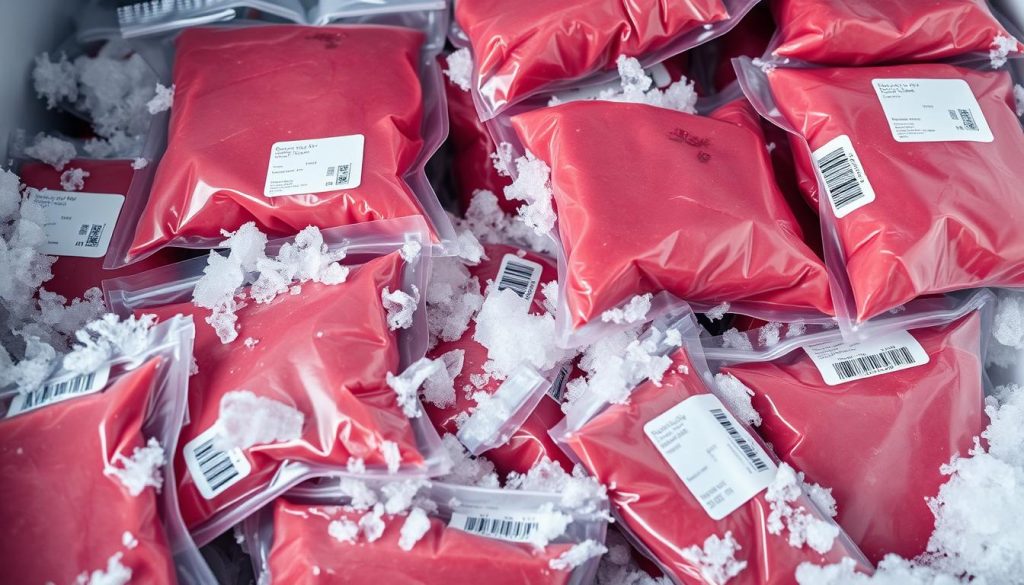We all want to eat foods that are good for us, and beef liver is a great choice. It’s full of vitamins and minerals that are good for our health. But, beef liver doesn’t last long, so we need to store it right to keep it fresh.
The USDA says we should eat beef liver within 1 to 2 days after putting it in the fridge. It’s also important to keep it at 40°F (4°C) or colder. Freezing it keeps it good for 3 to 4 months, as long as your freezer stays at 0°F (-18°C).
Understanding the Shelf Life of Beef Liver
Freshness Factors for Beef Liver in Refrigeration
How Long Does Beef Liver Last in the Fridge
Storage Guidelines for Optimal Liver Freshness
Tips for Extending the Life of Liver in the Fridge
Maximizing Liver Shelf Life by Freezing
Detecting Spoilage in Beef Liver
Health Benefits and Risks of Consuming Liver
Defrosting Frozen Liver Safely
Key Takeaways
- Beef liver should be eaten within 1 to 2 days in the fridge for best quality and safety.
- Keep beef liver in the fridge at 40°F (4°C) or colder for proper storage.
- Freezing beef liver keeps it fresh for 3 to 4 months at 0°F (-18°C).
- Beef liver is rich in nutrients like Vitamin A, Vitamin B12, and copper, as per the RDI.
- Organ meats like beef liver are packed with nutrients but should be eaten in moderation.
- Always check for spoilage signs like color, smell, and texture changes before cooking or eating beef liver.
- Thawing frozen beef liver in the fridge is key for both safety and quality.
Understanding the Shelf Life of Beef Liver
When we talk about beef liver storage life and organ meat shelf life, it’s key to note that it’s shorter than other meats. This is because of its high enzyme and blood content, making it spoil faster. To get the most nutritional benefits from beef liver, which is packed with vitamins and minerals, timing is everything.
The best time to store beef liver in the fridge is 1 to 2 days. After that, it starts to lose its nutritional value and taste.
- Nutritional Breakdown of Beef Liver (per 4 oz): High in protein (52% RDA) and extremely rich in Vitamin B12 (1,190% RDA) and Vitamin A (380% RDA), making it a powerhouse for maintaining good health.
- Difference in Grass-Fed Liver: Grass-fed and finished beef livers not only offer a silkier texture and a milder taste but are also higher in CLAs, which are known for their anti-cancer properties.
It’s important to know how quickly beef liver can go from fresh to unsafe. Eating spoiled organ meats can cause severe stomach problems. In some cases, organ meats can even have maggots if not stored correctly.
To get the most health benefits from beef liver, we must handle it quickly and correctly after buying. Let’s make sure to eat it within its safe time frame. This way, we can enjoy its taste and health perks fully.
Freshness Factors for Beef Liver in Refrigeration
Storing beef liver in your fridge requires understanding key factors for freshness and safety. Knowing how to check these factors ensures the liver is tasty and healthy.
Assessing Color and Texture
To check beef liver freshness, look at its color and texture. Fresh liver is bright red, without brown or gray spots. These signs indicate aging or poor handling. It should feel firm and slightly moist, not slimy.
If it’s slimy or sticky, it’s likely spoiled. This is a key beef liver quality indicator that it’s no longer good to eat.
Importance of Temperature Control
Keeping the optimal liver storage temperature in your fridge is critical. The USDA advises keeping refrigerated beef liver at 40°F (4°C) or below. This stops harmful bacteria growth and keeps the liver safe to eat for 1 to 2 days after buying.
Let’s look at some scientific data to see why proper storage matters:
| Parameter | Beef Liver | Beef Lungs |
|---|---|---|
| pH Value | Declines until 96 hours | Declines until 48 hours |
| L* Value (Lightness) | Increases during storage | Decreases during storage |
| a* and b* Values (Redness and Yellowness) | Slight increase | No significant change |
| NPN Content (mg/100g) | Increases, indicating spoilage at 2.35 | Increases, less indicator of spoilage at 1.52 |
| Drip Loss | Increases, indicating moisture loss | Increases |
This data shows why correct storage for refrigerated beef liver is essential. Changes in NPN content and pH levels can signal spoilage. These signs mean it’s time to eat it or throw it away for safety.
How Long Does Beef Liver Last in the Fridge
Knowing how long to keep beef liver in the fridge is key to keeping it fresh and safe. Fresh beef liver can stay in the fridge for 1 to 2 days. If you need to keep it longer, freezing is the best way to keep its nutrients.
To store beef liver safely, the fridge must be at or below 40°F (4°C). This stops harmful bacteria from growing. It keeps the liver’s quality and taste good. Following these steps helps you enjoy beef liver’s health benefits safely.
| Storage Method | Duration | Notes |
|---|---|---|
| Refrigeration (Fresh) | 1-2 days | Keep at < 40°F (4°C) |
| Freezing | 3-4 months | Store in airtight containers |
When storing beef liver, use a sealed container or wrap it tightly in plastic. This stops air from getting in, which can spoil it faster. Following these steps helps you store beef liver safely.

- Always check the liver’s color and texture before use; it should have a bright, deep red color without any slimy coating or off-odors.
- If the liver has been thawed, do not re-freeze it as this can affect the texture and flavor.
- Consume cooked liver within 3-4 days when stored in the refrigerator to enjoy its best quality.
We know how important it is to keep your liver fresh and stored safely. By following these guidelines, you can add this nutritious meat to your diet without worrying about food safety.
Storage Guidelines for Optimal Liver Freshness
Keeping liver fresh is key. Knowing how to store beef liver is essential. Refrigerate it right away after buying. This keeps it fresh and safe to eat.
Use the original packaging to prevent contamination and dryness. If the packaging is torn, place the liver in a shallow dish. Cover it with plastic wrap or aluminum foil. This stops air from spoiling the liver.
Here are specific storage times and conditions to help you keep your liver at its best:
| Product | Refrigerator (1-2 Days) | Freezer (3-4 Months) |
|---|---|---|
| Beef Liver | Consume within 1-2 days | Up to 4 months |
| Variety Meats (Tongue, Kidneys, Heart) | Consume within 1-2 days | Up to 4 months |
| Poultry Liver, Giblets | Consume within 1-2 days | Up to 4 months |
| Cooked Liver Leftovers | Not recommended | 2-3 months |
| Deli Liver Products | 3-5 days | Does not freeze well |
Raw or cooked liver, the guidelines help keep it fresh. Each liver type has its own needs. Meeting these ensures the best quality.
Quick cooling is vital for liver freshness. It stops bacteria from growing. This keeps the liver safe and of high quality.
By following these tips, you can enjoy liver dishes. Proper storage is key for safety and taste.
Tips for Extending the Life of Liver in the Fridge
We all want to keep our food fresh and of high quality. With so much food wasted, it’s key to store liver well. Here are some tips to help you keep your beef liver fresh longer.
Proper Packaging Techniques
Wrapping beef liver right is key to keeping it fresh. After buying, it’s important to use airtight packaging. You can:
- Wrap it in heavy-duty foil, plastic wrap, or freezer paper. This reduces freezer burn and keeps quality high.
- For longer storage, vacuum sealing is best. It removes air, keeping the liver fresh.
Using these packaging beef liver methods not only keeps it fresh longer. It also preserves its nutrients, like vitamin A and B vitamins, which are good for health.
Handling Liver Post-Purchase
Correct handling of beef liver after buying is critical. Try to keep it cold as soon as possible. Here’s how:
- Don’t let the liver sit at room temperature for too long. It should stay cold for less than two hours.
- Refrigerate or freeze it as soon as you get home. If refrigerating, keep it in the coldest part of your fridge.
For more on beef liver and its benefits, visit this resource.
| Storage Method | Duration | Notes |
|---|---|---|
| Refrigeration (original packaging) | 1-2 days | Maintain a temperature of 0-4°C |
| Refrigeration (airtight sealing) | up to 4 days | Use vacuum seal or heavy-duty wrap |
| Freezing | up to 4 months | Wrap with wax-lined butcher paper |
Following these tips can help you store liver safely and for longer. It’s not just about keeping it fresh. It’s also about keeping your family healthy.
Maximizing Liver Shelf Life by Freezing
Freezing is a top choice for keeping beef liver fresh. A good beef liver freezing guide helps keep the meat safe and full of nutrients. The USDA says freezing at 0°F (-18°C) stops bacteria and enzymes that spoil food.
Right packaging is key for preserving liver by freezing. Use heavy-duty foil, thick bags, or airtight containers to avoid freezer burn. Clean and cut the liver before freezing. Labeling packages helps keep track of when you froze them.
Liver can be frozen forever at the right temperature. But for the best taste and texture, eat it within 3 to 4 months. Here’s a table with storage times for different frozen meats:
| Meat Type | Maximum Storage Time (Months) |
|---|---|
| Beef Liver | 3-4 |
| Beef Roasts | 4-12 |
| Beef Steaks | 6-12 |
| Pork Chops | 4-6 |
| Ground Beef | 3-4 |
| Whole Chicken/Turkey | 12 |
| Chicken Parts | 9 |

Following these tips helps keep frozen beef liver at its best. Keeping your freezer at a steady temperature is key. This ensures your liver stays safe and tasty.
This guide should help you freeze liver well, keeping your food both tasty and safe. Enjoy your freezing adventures!
Detecting Spoilage in Beef Liver
When you handle beef liver, it’s key to spot spoilage signs. This ensures your meals are safe and tasty. Knowing how liver changes when it goes bad is important.
Visual and Olfactory Clues
Beef liver’s look and smell change when it spoils. Fresh liver is bright red, smooth, and has a metallic smell. Any difference means it might not be good anymore. Here are the main signs to watch:
- Color Changes: A dull, dark brown or greenish color means it’s not fresh.
- Surface Texture: If it feels sticky or slimy, it’s likely spoiled.
- Unusual Odors: A sour or ammonia smell is a clear sign of spoilage.
What Changes to Expect Over Time
Knowing how liver changes helps keep it fresh. Its high protein and moisture make it spoil quickly:
- Fading Color: Its bright red color fades to duller shades over time.
- Texture Transformation: It starts smooth but gets tacky and slimy as it spoils.
- Odor Development: Fresh liver smells mild and metallic. Spoiled liver smells rancid or like ammonia.
Spotting these spoilage signs helps keep your liver safe to eat. Throw away any liver that shows signs of spoilage. Remember, fresh beef liver should be eaten within 1-2 days for best safety and taste.
Health Benefits and Risks of Consuming Liver
Liver is packed with nutrients, making it a great addition to your diet. It’s rich in vitamins and minerals that boost your health. But, it’s important to know the risks of eating liver too.
Beef liver is known for its high nutrient content. It has lots of Vitamin A, which is good for your eyes. It also has B vitamins, which help your body work right. But, eating too much can cause vitamin A toxicity, so eat it in moderation.
Liver is also a great source of protein. Grass-fed beef liver is even better, with more nutrients than grain-fed liver. It has conjugated linoleic acid (CLA) and is free from toxins found in processed foods.
Even with its benefits, liver has some risks. It has a lot of cholesterol and saturated fat, which can harm your heart if eaten too much. Also, liver can have pollutants like heavy metals. So, it’s best to get liver from organic farms.
| Nutrient | Percentage of Daily Value (%DV) in a 4oz serving | Notes |
|---|---|---|
| Vitamin A | 380% | Essential for vision and immune function |
| Vitamin B12 | 1,190% | Supports nerve function and red blood cell development |
| Iron | 25% | Crucial for oxygen transport and energy production |
| Protein | 52% | Builds and repairs tissues |
| Selenium | 60% | Important antioxidant that helps prevent cellular damage |
In conclusion, liver is very nutritious but should be eaten in moderation. Knowing the risks helps you enjoy liver safely. With careful choice and balanced eating, liver can be a healthy part of your diet.
Defrosting Frozen Liver Safely
Defrosting beef liver safely is key to keeping its nutritional value. The Refrigerator Method is the best way to thaw liver without losing quality. It takes about 10 to 12 hours for a 10 to 12 oz. liver steak to thaw at 40 degrees Fahrenheit.
This slow thawing prevents harmful bacteria from growing. It keeps the liver safe from the danger zone of temperatures above 40 degrees.
Thawing Methods and Safety Precautions
Thawing beef liver properly is important for food safety. Larger cuts need careful planning, thawing for 24 hours for every 5 pounds in the fridge. Avoid using hot water or the microwave, as they can thaw unevenly and raise temperatures too high.
Ground liver and smaller cuts also need a full day to thaw in the fridge. This keeps them safe and of high quality.
Effect of Thawing on Liver Quality
Thawing liver correctly is important for its quality. Once thawed, liver should be eaten within 1 to 2 days for the best taste and nutrition. Ground liver has a shorter shelf life and should be eaten quickly.
After thawing, liver should not be refrozen. This can change its texture and lead to spoilage. For the best taste, cook the liver to an internal temperature of 160°F (71°C). Following proper thawing techniques helps us enjoy the full benefits of this nutritious organ meat.




